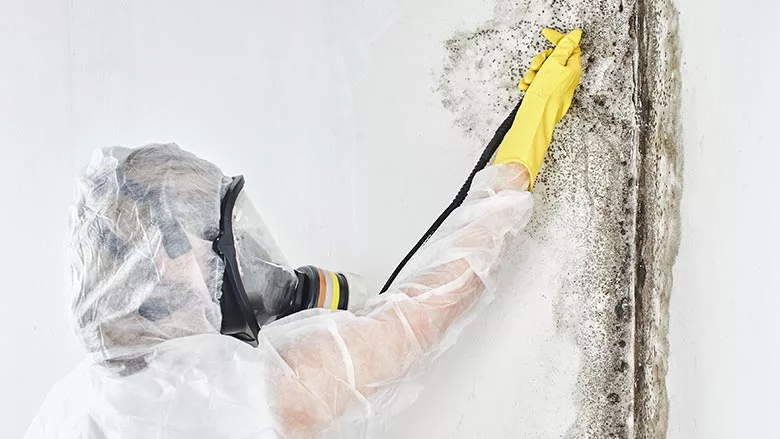Mold keeps growing long after Ike left town
HOUSTON – February 4, 2009 (Beaumont Enterprise) -- After Hurricane Ike tore through the Texas Gulf Coast on Sept. 13, millions of homes and businesses, many that had sustained some level of water damage, were left without power for days or even weeks.
The warm, damp conditions were perfect breeding grounds for an insidious invader: mold.
At a recent Hurricane Ike conference in Houston, Sara Speer Selber, an advocate for healthy, environmentally friendly building materials, asked a group of about 50 people how many had tested their homes for mold.
Very few raised their hands.
With a vast number of Gulf Coast residents are in some stage of the rebuilding process, many are thinking in terms of rebuilding "green."
But Selber, president of BuildClean, a nonprofit organization, said that's not enough.
They need to think "clean" and "geographically appropriate" as well.
Selber said that in her talks and seminars, she asks people to define "green."
"I have everybody list what does "green" mean," she said. "They use words like 'sustainable,' 'eco-friendly,' energy-efficient' and 'environmentally friendly.' I don't think I've every heard anyone say 'healthy."
Selber said a lot of emphasis is placed on sustainable and energy efficient materials and building practices while the importance of indoor air quality is virtually ignored.
Testing for mold is inexpensive and probably a good idea for anyone in the aftermath of a hurricane, Selber said.
According to the Centers for Disease Control and Prevention, mold can cause symptoms ranging from mild allergic reactions such as nasal congestions, eye irritation, wheezing or skin irritation to severe reactions including fever and shortness of breath. Chronic lung disease sufferers might develop mold infections.
Children and those with weakened immune systems are most susceptible to mold-related maladies.
Mold is just one health risk that can be alleviated by using geographically appropriate materials, Selber said.
"If you are rebuilding, rebuild knowing that we live on the Gulf Coast," she said. "It's a humid environment subject to floods."
Rather than paper-based drywall and standard forms of insulation, think gypsum wall board and mold-barrier insulation.
The two things mold needs to thrive are a food source and a water source.
Wet paper-based drywall can provide both in abundance.
Selber said some mold remediation can be done by residents, with the proper guidance.
But experts are available as well.
Mark Hebert of BreatheEasy is a mold assessment consultant.
His company uses thermal imaging cameras to detect mold.
He said signs of a possible mold problem in a home or business are allergy symptoms such as sneezing, watery eyes, coughing and itchiness.
He said mold is rampant in Southeast Texas after Hurricane Ike, particularly in the areas affected by the storm surge.
"Bridge City is going to be the mold capital of the nation for the next five years," he said.
Hebert said an important part of mold remediation is properly drying out the building.
"It takes 12 days to dry out a house and people are doing it for four days," he said.
Another part of indoor air quality involves using materials that do not emit volatile organic compounds such as formaldehyde, Selber said.
"You can buy products that don't contain VOCs, such as VOC-free paint, carpet, insulation and it's really not that much more expensive," she added.
Selber also suggested that for people in the process of rebuilding, this is an ideal time to test for other substances like radon, asbestos and lead.
The warm, damp conditions were perfect breeding grounds for an insidious invader: mold.
At a recent Hurricane Ike conference in Houston, Sara Speer Selber, an advocate for healthy, environmentally friendly building materials, asked a group of about 50 people how many had tested their homes for mold.
Very few raised their hands.
With a vast number of Gulf Coast residents are in some stage of the rebuilding process, many are thinking in terms of rebuilding "green."
But Selber, president of BuildClean, a nonprofit organization, said that's not enough.
They need to think "clean" and "geographically appropriate" as well.
Selber said that in her talks and seminars, she asks people to define "green."
"I have everybody list what does "green" mean," she said. "They use words like 'sustainable,' 'eco-friendly,' energy-efficient' and 'environmentally friendly.' I don't think I've every heard anyone say 'healthy."
Selber said a lot of emphasis is placed on sustainable and energy efficient materials and building practices while the importance of indoor air quality is virtually ignored.
Testing for mold is inexpensive and probably a good idea for anyone in the aftermath of a hurricane, Selber said.
According to the Centers for Disease Control and Prevention, mold can cause symptoms ranging from mild allergic reactions such as nasal congestions, eye irritation, wheezing or skin irritation to severe reactions including fever and shortness of breath. Chronic lung disease sufferers might develop mold infections.
Children and those with weakened immune systems are most susceptible to mold-related maladies.
Mold is just one health risk that can be alleviated by using geographically appropriate materials, Selber said.
"If you are rebuilding, rebuild knowing that we live on the Gulf Coast," she said. "It's a humid environment subject to floods."
Rather than paper-based drywall and standard forms of insulation, think gypsum wall board and mold-barrier insulation.
The two things mold needs to thrive are a food source and a water source.
Wet paper-based drywall can provide both in abundance.
Selber said some mold remediation can be done by residents, with the proper guidance.
But experts are available as well.
Mark Hebert of BreatheEasy is a mold assessment consultant.
His company uses thermal imaging cameras to detect mold.
He said signs of a possible mold problem in a home or business are allergy symptoms such as sneezing, watery eyes, coughing and itchiness.
He said mold is rampant in Southeast Texas after Hurricane Ike, particularly in the areas affected by the storm surge.
"Bridge City is going to be the mold capital of the nation for the next five years," he said.
Hebert said an important part of mold remediation is properly drying out the building.
"It takes 12 days to dry out a house and people are doing it for four days," he said.
Another part of indoor air quality involves using materials that do not emit volatile organic compounds such as formaldehyde, Selber said.
"You can buy products that don't contain VOCs, such as VOC-free paint, carpet, insulation and it's really not that much more expensive," she added.
Selber also suggested that for people in the process of rebuilding, this is an ideal time to test for other substances like radon, asbestos and lead.
Looking for a reprint of this article?
From high-res PDFs to custom plaques, order your copy today!




